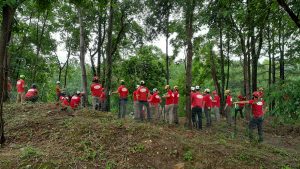 Richmond is home to a diverse and beautiful urban forest, filled with mature trees that add character and value to properties throughout the city. However, many of these trees were planted decades ago—long before today’s homes, roads, and infrastructure existed. As a result, some trees now grow in tight, confined spaces or under environmental stress that impacts their long-term health and stability.
Richmond is home to a diverse and beautiful urban forest, filled with mature trees that add character and value to properties throughout the city. However, many of these trees were planted decades ago—long before today’s homes, roads, and infrastructure existed. As a result, some trees now grow in tight, confined spaces or under environmental stress that impacts their long-term health and stability.
In these situations, a tree growth regulator (TGR) can be a helpful tool to manage canopy size and promote healthy root development below ground. TGRs can also be used to manage the size and health of shrubs, significantly reducing their growth rate and maintenance needs.
In a typical growing season, many trees can put on 12 to 24 inches of new vertical growth. With a TGR application, this growth is significantly reduced. TGRs gently and predictably slow the vegetative growth of trees. You may also see smaller leaves and tighter spacing between nodes, which can benefit water conservation.
TGRs work by shrinking the stomata—tiny pores on the surface of leaves responsible for gas exchange—resulting in improved water retention. This shift in energy allocation encourages the tree to invest more in root development and internal strengthening, which can improve its ability to tolerate stress from drought, construction, and compacted soil.
Additionally, systemic plant growth regulators can control the size and shape of tree branches, particularly in urban environments where limbs may encroach on utility lines.
Th ere are several strategic reasons to consider using a tree growth regulator on your property. TGRs help manage the accelerated growth rate and overall size of trees, making them more suitable for urban environments. They are essential tools for managing and controlling tree growth in various landscapes. TGRs also enhance disease resistance by improving the tree’s fibrous root growth and overall health.
ere are several strategic reasons to consider using a tree growth regulator on your property. TGRs help manage the accelerated growth rate and overall size of trees, making them more suitable for urban environments. They are essential tools for managing and controlling tree growth in various landscapes. TGRs also enhance disease resistance by improving the tree’s fibrous root growth and overall health.
TGRs are not a one-size-fits-all solution, but when applied correctly, they can support tree health in specific, often challenging environments.
Urban settings often leave little room for trees to expand. When trees are planted too close to buildings, driveways, or sidewalks, excessive growth can cause structural issues or lead to frequent, aggressive pruning.
TGRs can significantly reduce the need for pruning, thereby decreasing maintenance efforts. TGRs can help slow canopy growth, maintaining a safer and more manageable size without compromising the tree’s overall vitality.
Construction projects near trees often result in root disturbance, compacted soil, or physical damage. Applying a TGR can help redirect a tree’s energy away from canopy expansion and toward root regeneration, giving the tree a better chance to recover and reestablish itself.
In periods of drought or inconsistent rainfall, trees can suffer from water stress. TGRs help trees improve carbohydrate storage, which is crucial for maintaining energy reserves during periods of drought. By reducing the rate of transpiration through smaller leaves and tighter stomata, a TGR application can help trees retain more moisture, support cellular function even in dry conditions, and aid in the ability to ripen fruit.
Some trees may struggle due to poor root structure, limited space underground, or compacted soils. TGRs help stimulate the growth of fine roots, which are essential for nutrient uptake and water absorption, thereby improving the tree’s ability to absorb essential nutrients and enhancing the overall health and resilience of the tree.
TGR treatments are designed to be minimally invasive, with little to no disruption to your landscape. A certified arborist can apply the solution using one of two methods:
- Trenching Method: A shallow trench (2–3 inches deep) is dug in a ring around the base of the tree, just at the root flare. The growth regulator is then applied evenly around the entire circumference of the tree.
- Soil Injection Method: Alternatively, the arborist may use a specialized injection tool to apply small, measured doses of the solution directly into the soil surrounding the root zone.
TGRs are a systemic chemical solution that is absorbed through the roots and transported throughout the tree’s vascular system.
Once the treatment is applied, the tree naturally absorbs the solution through its roots. From there, the active ingredients are transported throughout the tree’s vascular system, typically becoming fully effective within a few weeks. The effects of a single application generally last two to three years.
While growth regulators produce many benefits, they are not suitable for every tree or every situation. Certain species, such as Japanese Maples and Lacewing Elms, may react poorly to these treatments. Additionally, overuse or improper application can lead to negative effects, such as overly small leaves, chlorosis, or stunted long-term growth.
Treated trees may exhibit different growth patterns and health benefits compared to untreated trees. Growth regulators that inhibit gibberellin can lead to reduced shoot and branch elongation, making trees more manageable in urban environments. These treated trees not only show reduced growth but also improved health and resilience to pathogens.
Before proceeding with any growth regulation treatment, it’s important to understand the tree’s species, current health status, and history of care. Because TGRs remain active in the tree’s system for several years, timing and dosage are critical. That’s why consulting with a Certified Arborist is always recommended—they can assess whether your tree is a good candidate and ensure that any application is done safely and effectively.
If you’re considering a tree growth regulator treatment in Richmond, the experienced team at Truetimber Arborists is here to help. Our knowledgeable Tree Care Advisors can evaluate your trees, assess site conditions, and determine whether a TGR application is the right choice for your landscape.
We also offer growth regulator services for landscape ornamentals, helping to manage their growth and health.
We’re committed to helping you make informed, responsible decisions for your trees—always with their long-term health in mind. Contact us today to schedule a consultation and take the next step in supporting your trees with professional care.
 Richmond is home to a diverse and beautiful urban forest, filled with mature trees that add character and value to properties throughout the city. However, many of these trees were planted decades ago—long before today’s homes, roads, and infrastructure existed. As a result, some trees now grow in tight, confined spaces or under environmental stress that impacts their long-term health and stability.
Richmond is home to a diverse and beautiful urban forest, filled with mature trees that add character and value to properties throughout the city. However, many of these trees were planted decades ago—long before today’s homes, roads, and infrastructure existed. As a result, some trees now grow in tight, confined spaces or under environmental stress that impacts their long-term health and stability.
 ere are several strategic reasons to consider using a tree growth regulator on your property. TGRs help manage the accelerated growth rate and overall size of trees, making them more suitable for urban environments. They are essential tools for managing and controlling tree growth in various landscapes. TGRs also enhance disease resistance by improving the tree’s fibrous root growth and overall health.
ere are several strategic reasons to consider using a tree growth regulator on your property. TGRs help manage the accelerated growth rate and overall size of trees, making them more suitable for urban environments. They are essential tools for managing and controlling tree growth in various landscapes. TGRs also enhance disease resistance by improving the tree’s fibrous root growth and overall health.